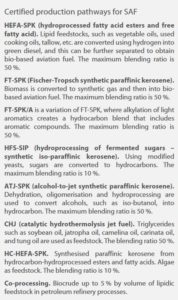What are Sustainable Aviation Fuels? What is their environmental impact? Can aviation be sustainable? Let’s find out.
Definition of Sustainable Aviation Fuel
There is no oficial definition of Sustainable Aviation Fuel. SAF may be defined as bio-based aviation fuels that reduce greenhouse gas emissions relative to conventional aviation fuel. SAF are produced out of non-fossil sources such as woody biomass, hydrogenated fats and oils, recycled waste or other renewable sources. The emissions reductions are achieved in their production process.The CO2 absorbed during plant growth is supposed to compensate for some of the CO2 emitted when the fuel is burnt. To be considered sustainable, an aviation fuel has to comply with other environmental and social requirements such as biodiversity, land use (forests, wetlands, peatlands), water, labour standards applied in production processes and support to the social and economic development of communities involved in fuel production.
Eight production pathways have been certified for use in civil aviation, under the standards of American Society for Testing and Materials (ASTM) (see box below).

One can note almost all of them are mixed with petroleum-based fuel. Why is that? Blending is necessary as some conventional fuel components allow seals to swell in older engines and prevent fuel leaks.
Can SAF replace petroleum-based fuels?
Despite the vivid interest for more sustainable aviation fuels, SAF still represents a tiny share of the aviation fuel market. According to the European Union Aviation Safety Agency, 2.3 million tonnes of SAF are produced every year which potentially corresponds to about 4% of the total EU conventional fossil aviation fuel demand. Two main reasons can explain this slow development. First of all, SAF are still very expensive. A tonne of fossil-based aviation fuel costs €600 while a tonne of SAF can be in the range of €950-€1,015. The second reason is that bio-based aviation fuel production enters in competition with bio-based road fuel production. The amount of biomass is limited.
What are the SAF’s environmental impacts?
According to the European Commission, direct emissions from aviation represent 3 % of the EU’s total greenhouse gas emissions and more than 2 % of global emissions. Sustainable aviation fuels are seen as a way to reduce these emissions as the biomass used to produce them would absorb CO2 while growing. In fact, the emissions reductions depend a lot on the way the biomass is obtained. A 2019 study of the International Civil Aviation Organization evaluated the indirect land use change (ILUC) emission intensity of different bio-based aviation fuels. For example, the ILUC emission intensity of a fuel made out of palm oil in Indonesia would be 24 times higher than the one of a switch grass-based fuel. This is due to the deforestation of Indonesia’s forests.
A second challenge faced by SAF production is land occupation. Sustainable aviation fuel production should not threaten the capacity for humanity to feed herself. The bio-based fuels using agroindustry wastes would have the most positive impact on the environment
Sustainable Aviation Fuels may have a better environmental impact than the fossil-based ones but are not the unique solution to aviation emissions. In order to effectively reduce the environmental impact of this sector, we should reduce the use of planes.
Learn more about bio-based fuels (article in French)